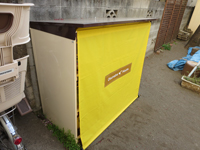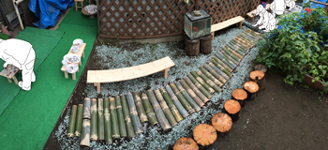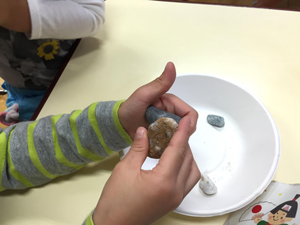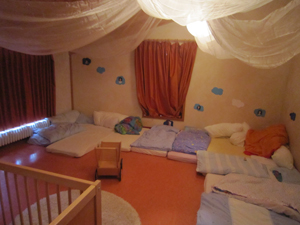Creating Childcare Environments
- Technique 01: How to capture childcare environments--examples of Japan and Sweden
- Technique 02: Building a broad personal network through the creation of childcare environments
- Technique 03: Technique to change childcare environments
- Technique 04: The value of outdoor environments in Denmark
- Technique 05: Fostering children's emotional development in childcare environments by providing "real things" (This article)
- Technique 06: How to understand the meaning and value of the shape of things through the construction of custom-made childcare facilities--Example of a German kindergarten
In my previous posts, I explained the importance of creating a childcare environment by linking the thoughts of childcare workers to the actual conditions of their environment, considering the specific objectives of the environment, such as for whom and what purpose it is created. I have also discussed the effects of creating childcare environments, focusing on the emotional movements of children, such as calming or motivating children (i.e. psychological effects). In this session, I will explain another role of creating childcare environments, which fosters children's emotional development towards the nature of things. One such example is the use of Geijutsushi (artists with expressive expertise and specialized knowledge to day-care centers) in childcare scenes. CRN previously published an article titled "'Geijutsushi' at Day-care Centers", which introduced the new initiatives of professional artists offering activities such as drawing a picture or making an item of clothing. This article shows us how effectively the artists support children's emotional development through such activities. In other words, these day-care centers and kindergartens have incorporated "real things" instead of "kid's versions of things" into their childcare practice. I hope this Geijutsushi program will be adopted widely across the country; however, it may be difficult to achieve this in a short period of time. Therefore, in this session, I will discuss a way of creating childcare environments that are achievable by anyone, anywhere. We will re-think the importance of childcare workers' involvement in creating childcare environments, which will enhance children's emotional development.
Involvement of childcare workers in the process of creation will convey their thoughts to children
Photographs 01 and 02 show the playground-initiative of Shinagawa Ward Higashi-Nakanobu Daycare Center. The daycare center created a new space using an infrequently used area between a sandbox and a parting wall within the playground. The corner of this playground is often used to store gardening tools and play equipment and rarely used for children's activities. However, the childcare workers at the daycare center focused on this cramped area and successfully changed the environment. From a physical perspective, the corner is now a place where the children can get a view of the entire playground, offering them a wider area to hang around in, and making the entire place (the playground in this case) feel more spacious.
 |
 |
|
| Photograph 01: Corner of the schoolyard at Shinagawa Ward Higashi-Nakanobu Daycare Center, April 2014. (left) Photograph 02: Same corner shown in Photo 01, in which the childcare workers planned and created a new environment, November 2014. (right) |
||
What I want to convey most in this example is that the childcare workers discussed and determined what was needed for the daycare center in creating childcare environments and were involved in the process of creation. They added new materials such as wood scraps (wooden boards and tree stumps cut by children's fathers as shown in the right part of Photo 02), pieces of bamboo and two types of purchased pebbles to the corner of the playground. In addition, before the childcare workers took the children out to the playground for the first time after the space was created, they explained to the children about their experience in creating the new corner space as well as materials used in the space (Photo 03).
The children (four-year-olds class) sniffed at the stumps and bamboo pathway and brushed their cheeks against them. When they touched a small pebble, they commented, "It's cold and smooth, but becomes warm after holding it for a while." Some children picked up two pieces of half-cut bamboo from the ground (Photo 02) and put them together to see the original shape of it. This is probably because they were explained in advance that the bamboo had been cut into pieces and used to create the pathway.
In this way, the involvement of the childcare workers in the process of discussion and construction provided the children with new topics to explore about the materials in the playground. This process is also a part of creating a childcare environment that can enhance children's emotional development. It is important to determine "what to prepare" for children, but it is also worth re-considering the importance of "how to prepare" them.

Photograph 03: Child touching a pebble used in the construction of the playground
Providing a memorable scene for children
I previously conducted research using a "Sound Quiz" for children to figure out how children recognize their childcare environment through sounds (Note). For example, I gave them the sound of wind chimes hanging near a swimming pool in the playground. Some children responded "This is the sound of jumping into the swimming pool," instead of saying "The sound of wind chimes." Likewise, when I indicated the music used in the lunch room, the children answered "This is the sound I hear when I have lunch with XX."
As a result of this research, I confirmed that the sound environment is not necessarily recognized as the source of the sound. Children recognize the sounds associated with their experience, and hence, remember the sounds with places and activities they have been engaged in. Currently, the members of my laboratory are conducting research concerning the relationship between colors and the recognition of environment. We often say "the sound when I'm doing XX" but rarely say "the color when I'm doing XX." Therefore, there may be different clues for the relationship between colors and the recognition of environment. It also seems that a silent space (or a quiet room to spend quiet time) and a napping space (see Photo 04), which I rarely see in Japan, will provide more chances to get such clues as they have fewer sound factors.
The potential of each childcare environment in fostering children's emotional development can be enhanced if we understand and appreciate the synergy effect of each factor such as sounds, colors and materials. It may be interesting to change a childcare room as if we are a "sommelier of childcare environments" describing an ideal environment where children can spend time and play.

Photograph 04: Napping room at Entdeckerhaus, a KITA facility (Kindertagesstätte; an integrated facility of kindergarten and daycare center functions) in Bremen, Germany
Note: "Hoikushisetsu ni okeru youji no oto kankyou ninshiki ni kansuru kenkyuu" [Study on children's recognition of sound environments at childcare facilities" written by Masayuki Sato, Saki Noguchi, and Masashiro Wakamori, p.102, No.1, Vol.6 of "Child, Youth and Environmental Studies", 2010



 Masayuki Sato, Associate Professor, Department of Human Behavior and Environment Sciences, Waseda University
Masayuki Sato, Associate Professor, Department of Human Behavior and Environment Sciences, Waseda University










